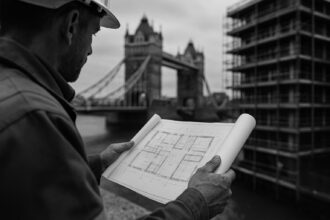The closure of Worthing’s ageing Grafton car park has drawn criticism from residents over persistent lighting costs, even as the council pushes forward with ambitious plans to demolish the underused site and develop new homes, shops, and leisure spaces.
The closure of the Grafton car park on Worthing seafront has sparked significant public discontent, particularly from local residents like John Hill, a 74-year-old from Sompting. Following reports of “falling concrete” and the building’s ageing state—having been constructed over sixty years ago—the Worthing Borough Council deemed it necessary to conduct an urgent investigation. However, Mr Hill’s concerns extend beyond structural integrity; he is frustrated by the fact that the car park’s lights remain on despite its closure, leading him to describe the situation as reminiscent of the “Blackpool illuminations.”
Mr Hill’s critique highlights a broader issue regarding fiscal responsibility in local governance. He pointedly remarked, “With all the cutbacks the council is having to make at the minute, it’s an absolute disgrace.” The council is reportedly facing ongoing budget constraints, which has heightened scrutiny over expenditures, particularly unnecessary utilities like the lighting that Mr Hill believes could be costing the council thousands of pounds. Such concerns are emblematic of a wider discontent among residents, who often see local councils grappling with budget reductions while simultaneously funding projects that appear non-essential.
In a bid to revitalise the area and address the growing concerns surrounding the aging structure, Worthing Borough Council has announced plans to redevelop the Grafton car park site. According to the council’s proposals, the site, which spans roughly the area of a football pitch and includes not only the car park but also nearby shops and a bowling alley, is set for transformation into approximately 150 new homes, alongside commercial units and leisure facilities. This initiative aims not only to remove what has been described as an “eyesore” but also to create a vibrant community hub that links Montague Street to the seafront, thus enhancing the overall aesthetic and utility of the area.
Moreover, the council has expressed its determination to engage with the community throughout the redevelopment process to ensure that the project meets local needs. As part of this initiative, they are actively seeking a development partner. The proposed demolition of the Grafton car park has moved closer to fruition, with plans to market the site for sale commencing in January 2024. This shift is seen as critical to supporting the ongoing regeneration of the seafront and addressing the underutilisation of the car park, which, according to reports, only sees about a quarter of its 440 spaces occupied on average.
In the context of local governance, the Grafton car park saga serves as a microcosm of broader urban development challenges faced by towns grappling with ageing infrastructure and the pressing need for modernised facilities. While the council aims to take decisive steps towards revitalising Worthing’s waterfront, the immediate concerns of residents like Mr Hill underline the complexities of balancing financial accountability with community satisfaction and urban regeneration.
Reference Map:
Source: Noah Wire Services
- https://www.theargus.co.uk/news/25200736.worthing-mans-outrage-grafton-car-park-lights-left/?ref=rss – Please view link – unable to able to access data
- https://www.adur-worthing.gov.uk/grafton-car-park-worthing/ – The Grafton multi-storey car park in Worthing, built in 1960, is ageing and requires significant investment to maintain. The council plans to redevelop the site into approximately 150 homes and commercial units to revitalise the area. The redevelopment aims to transform the unattractive buildings into a vibrant community space, linking Montague Street to the seafront. The council is seeking a development partner to bring this vision to life, with ongoing community engagement to ensure the project meets local needs.
- https://www.adur-worthing.gov.uk/news/archive/pr23-152.html – In November 2023, Worthing Borough Council approved plans to sell the Grafton car park site to a developer for demolition and redevelopment. The proposal includes constructing at least 150 new homes, leisure facilities, commercial units, and green spaces. The council aims to remove ageing structures, provide much-needed housing, and support the regeneration of the seafront. The site, covering roughly the area of a football pitch, includes the 440-space car park, a bowling alley, and shops in Montague Street.
- https://www.sussexlive.co.uk/news/sussex-news/eyesore-worthing-town-centre-car-8885047 – The Grafton multi-storey car park in Worthing, described as an ‘eyesore’, could be demolished and replaced with at least 150 new homes. The redevelopment plan also includes enhanced leisure facilities, commercial units, and green spaces. The council aims to transform the area, remove unattractive buildings, and support the regeneration of the seafront. The proposal was discussed by the council’s cabinet, with plans to market the site for sale from January 2024.
- https://www.sussexexpress.co.uk/news/politics/council/major-plans-for-worthing-multi-storey-car-park-revealed-ugly-untidy-part-of-the-town-urgently-needs-to-be-transformed-4399904 – Worthing Borough Council has revealed major plans to transform the Grafton multi-storey car park. The council proposes selling the site to a developer for demolition and redevelopment into new homes and a gateway to the seafront. The plan includes at least 150 new homes, enhanced leisure facilities, commercial units, and green spaces. The council aims to remove ageing, unattractive buildings and support the regeneration of the seafront. The proposal was discussed by the council’s cabinet, with plans to market the site for sale from January 2024.
- https://www.bbc.com/news/uk-england-sussex-67380397 – Plans to demolish the Grafton multi-storey car park in Worthing have moved a step closer. The council approved plans to sell the site and neighbouring shops to a developer for redevelopment into 150 homes, leisure facilities, and commercial units. The car park, built in the 1960s, is underused, with only a quarter of its 440 spaces occupied on average. The council aims to transform the area and support the regeneration of the seafront. The site is set to be marketed for sale from January 2024.
- https://www.adur-worthing.gov.uk/parking/worthing-car-parks/ – Worthing Borough Council provides information on its car parks, including the Grafton multi-storey car park. The Grafton car park has 434 spaces, with 6 disabled spaces, and operates 24 hours a day. The council is considering redeveloping the Grafton site into new homes and commercial units to revitalise the area. The Buckingham Road multi-storey car park, which has been refurbished, and a new multi-storey car park in the Civil Quarter are expected to provide sufficient parking capacity to allow the Grafton car park to close.













